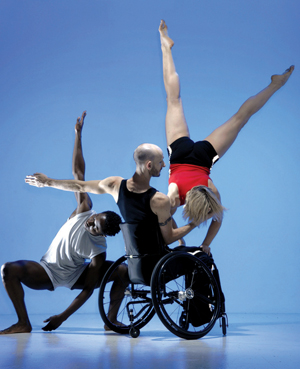Disabled dancers have fewer employment opportunities because of a lack of professional training. Stine Nilsen explains how Candoco hopes to redress the balance.

Why do we need to set up our own apprenticeship scheme for disabled dancers? The answer is pretty simple: we think we need to give disabled dancers more professional experience as dancers. When we see disabled dancers at our auditions we often find that they do have raw talent but less confidence and dance skills than their non-disabled peers. We know that much of this is to do with a lack of suitable vocational training. This is well documented, and despite involvement in several initiatives with vocational training schools over the past few years, there are still few disabled dancers in full-time rigorous training. There are also few employment opportunities for disabled dancers – but here we enter chicken and egg territory.
Jenny Sealey, Artistic Director of Graeae, thinks there is a “growing realisation that Shakespeare did not say whether Juliet was a wheelchair user or not”. This is great. Unfortunately, we don’t yet see evidence of a realisation in dance that Billy Elliot could have done his pirouettes in a wheelchair. Candoco needs dancers who have had rigorous, high-quality training, in order to create the kind of work that Candoco is renowned for, and in order to prepare their bodies to cope with the demands of a busy international touring and education schedule. For the last 19 years Candoco has informally supported the professional development of disabled artists through work experience, short shadowing opportunities, choreographic labs, residency weeks, three youth dance companies and our year-long full-time Foundation Course in Dance. The course ran from 2004–2008, and took 21 young disabled artists through a vocational training programme and into further training or performing arts employment.
With our new scheme, two apprentices per year will shadow the company for ten weeks each. They will take part in company class, touring, assisting in Candoco’s education workshops, and develop an individual physical training programme. They will learn part of the company’s current repertory, to experience what is like to work alongside Candoco’s dancers, as peers. We aim to pay apprentices for their time, as we believe that this will set the placement firmly in a professional context.
The apprenticeships will provide disabled artists with professional experience in order to be better qualified to enter a professional career, give Candoco greater knowledge of working with a variety of disabled dancers, and provide a structure to monitor outcomes and share learning. Eventually. It will allow Candoco to employ more disabled dancers safely, and show that there are highly skilled disabled dancers looking for work in mainstream companies, and it will allow Candoco to offer its expertise to the sector as the sector looks to diversify its own practice. There is currently no funding confirmed for the apprenticeship scheme. No one funding body is taking responsibility for the lack of proper vocational training for disabled artists. Candoco is working hard to address this issue with those who can do something about it and give disabled dancers the opportunities they need. Life at Candoco is certainly never quiet – when the tour ends and the schools go on holiday, we keep working on the issues that Candoco can advocate for on behalf of the sector.
Stine Nilsen is Co-Artistic Director of Candoco dance company.
w: http://www.candoco.co.uk



